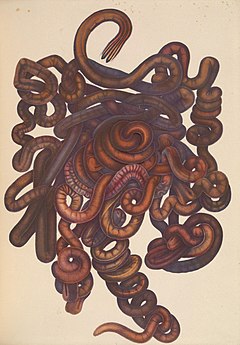Ver lacet
Lineus longissimus
| Règne | Animalia |
|---|---|
| Embranchement | Nemertea |
| Classe | Anopla |
| Ordre | Heteronemertea |
| Famille | Lineidae |
| Genre | Lineus |
Le ver lacet (Lineus longissimus) est une espèce de vers de l'embranchement des némertes, ou « vers rubans ». C'est le plus long des animaux connus, avec des spécimens qui atteignent 30 m[1], avec une longueur maximale enregistrée de 60 m[2].
Description et biologie
[modifier | modifier le code]Son corps semble capable de grandes extensions, comme tous les némertes grâce à son proboscis, et il ne mesure toutefois que 5 à 10 millimètres de diamètre. Son corps marron s'assombrit avec l'âge de l'individu, et possède des bandes longitudinales claires[3].
Il produit un mucus malodorant[3] et toxique[4].
Répartition géographique
[modifier | modifier le code]On rencontre ce ver le long des côtes de l'Europe du Nord (côte atlantique française, Manche, mer du Nord, Baltique), et il serait le plus commun des némertes des côtes britanniques[réf. nécessaire].
Liens externes
[modifier | modifier le code]- (en) Référence Catalogue of Life : Lineus longissimus (Gunnerus, 1770) (consulté le )
- (fr + en) Référence ITIS : Lineus longissimus (Gunnerus, 1770)
- (en) Référence WoRMS : espèce Lineus longissimus (Gunnerus, 1770)
- (en) Référence Animal Diversity Web : Lineus longissimus
- (en) Référence NCBI : Lineus longissimus (taxons inclus)
- (fr) Référence INPN : Lineus longissimus (Gunnerus, 1770) (TAXREF)
Notes et références
[modifier | modifier le code]- (en) http://afg.biodiversity.aq/species/15-lineus-longissimus
- (en) Cleveland P. Hickman, Integrated Principles of Zoology, Montréal, McGraw-Hill, , 14e éd., 910 p. (ISBN 978-0-07-297004-3), p. 307
- Ferdinand Adrien MARLETAZ, « Lineus longissimus Gunnerus, 1770 », STATION BIOLOGIQUE ROSCOFF,
- M. Strand, P. Sundberg, « Lineus longissimus », Långsnöre, p. 104, in Nationalnyckeln till Sveriges flora och fauna, Stjärnmaskar - slemmaskar, Sipuncula - Nemertea, Artdatabanken, SLU, Uppsala, 2010, (ISBN 978-91-88506-72-6).
Text is available under the CC BY-SA 4.0 license; additional terms may apply.
Images, videos and audio are available under their respective licenses.

